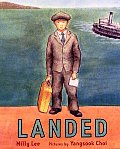by Andrea Baily, April Sanders, Patricia Sosa-Sanchez, University of North Texas, Denton, TX
When incorporating varied literature into school curriculum and/or the classroom, those choices should logically reflect many stories that eventually are woven into a mosaic of understanding, but are students getting this international perspective from the literature found in their classrooms and libraries?
Understanding the authentic immigrant experience necessitates exposure to international literature. Reading about such experiences gives a peek into the hearts and minds of people whom we may not fully understand. The reader is able to experience the struggles and triumphs of these characters; thus, we get a tiny glimpse of the world through the eyes of a person who has arrived at America’s doorstep. This glimpse is where we as readers learn empathy and acceptance for other cultures that face the task of maintaining their own heritage while living in a new country with possibly vastly different rules and structures. Without the authenticity provided by the immigrant voice, the reader may begin to form false ideas about a culture or simply form no ideas and be completely void of knowledge of their new fellow country mates.
Continue reading


 Milly Lee (2006) introduces readers to Sun Lee, a 12-year old Chinese boy, who immigrates to America in the book
Milly Lee (2006) introduces readers to Sun Lee, a 12-year old Chinese boy, who immigrates to America in the book